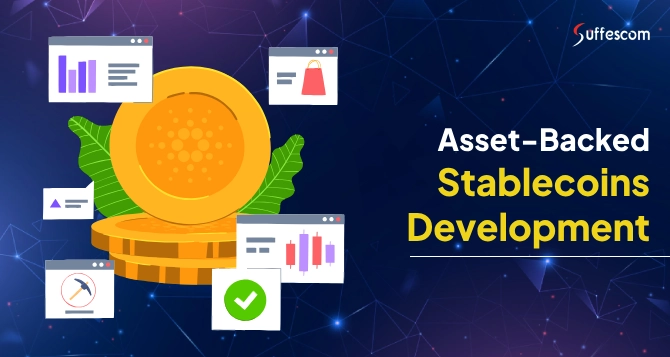What Makes Asset-Backed Stablecoins a Game-Changer? Find Out!

Simply put, stablecoins are a type of cryptocurrency designed to ensure stability, as their value is pegged to another asset, such as a fiat currency, commodity, gold, or real estate. These are a great alternative to highly volatile cryptos such as Bitcoin, making them suitable for everyday transactions.
High stablecoin transaction volumes prompt companies to prioritize asset-backed stablecoin development. Businesses exploring stablecoin remittance platform development are leveraging asset-backed stablecoins to create efficient, low-cost, and secure global payment solutions.
Before we delve into understanding asset-backed stablecoins and related development components, it is essential to grasp the concept of,
Stablecoins: For Utmost Stability
Companies utilize stablecoins in various blockchain-based financial services, enabling customers to make payments for products. We refer to them as 'stablecoins,' but that doesn't guarantee they will maintain their peg on secondary markets or that their reserves can cover every redemption request.
How Stablecoins Maintain Their Value?
Stablecoins maintain a stable value by pegging their market value to an external element, typically a fiat currency like the U.S. dollar, or a commodity such as gold. Ultimately, these crypto coins aim to deliver an alternative to the high volatility of popular cryptocurrencies.
Stablecoins are backed by an absolute value, whether from a fiat currency or a real-world asset. There's a dollar in the bank for every coin circulating in the market; such a provision ensures less volatility in the coin's value.
Additionally, some stablecoins employ digital mechanisms that involve sophisticated supply management techniques to maintain their value. Another reason the value is largely stabilized is due to users' higher trust.
Also note that the stablecoins’ ability to maintain value also depends upon the proficiency levels of the asset-backed stablecoins development services.
Asset-Backed Stablecoin Development for Promising Revenue Opportunities!
Earn transaction fees, get staking returns, and earn interest on reserve assets. All you need to do is connect with a professional asset-backed stablecoins development company.
Characteristics that Define Asset-Backed Stablecoins
How do you identify if a particular stablecoin is asset-backed? Several characteristics can help you out! Let's explore the essential traits included in the physical asset-backed stablecoin development!
1. Stable Value
The primary purpose of creating an asset-backed stablecoin is to ensure a consistently stable value that corresponds to the asset's reserve.
2. Backed by Real-World Assets
The value of asset-backed stablecoins is backed by the reserves of real-world assets such as gold or real estate held in reserve. Gold-backed stablecoin is another category of asset-backed stablecoins.
3. The Issuer Manages the Reserves
A central entity creates and manages such stablecoins. They are responsible and accountable for keeping the backing assets safe and ensuring there's enough to match the number of coins in circulation.
4. Higher Trust
People trust these stablecoins because the real assets in reserve are meant to guarantee their value.
Why Asset-Backed Stablecoins Development is Important?
Asset-backed cryptocurrencies have changed the way the cryptosystem works. It combines blockchain technology with real assets, giving investors and users multiple benefits. Read along to find out the benefits of physical asset-backed stablecoin development:
1. Revenue Stream
Earn interest or returns by investing the real-world assets held in reserve to back the stablecoin. Asset-backed stablecoins help generate revenue by charging a transaction fee imposed on every transaction.
2. Market Influence
The entity that develops and markets a stablecoin gets to influence the crypto market and leverage this influence to create stronger partnerships in the market.
3. Brand Recognition
Successful launch and marketing of stablecoin builds strong credibility, increasing trust and creating new business opportunities.
4. Access to Data
Gather valuable insights from user transactions and behavior, which is crucial for market analysis, targeted marketing, or monetization (while adhering to legal and privacy standards).
5. Higher Scalability
Once the stablecoin is operational, the owners can scale it to accommodate growing numbers of users and transactions with relative ease, provided the technology is robust.
6. Community Building
An extensive user base that comes with higher stablecoin usage is a ticket to building a stronger community that supports its growth, provides feedback, and increases adoption.
Knowing the Different Types of Stablecoins
The kind of stablecoin you want to develop will require a specialized development process; it could be a commodity-backed stablecoin development or something else. Stablecoins are classified into four major types, listed as;
1. Fiat-Collateralized Stablecoins
Fiat currencies such as USD or EURO peg the value of fiat-backed stablecoins in a 1:1 ratio.
For instance, an equivalent amount of US dollars held in reserve backs a US Dollar-backed stablecoin, such as USDT (Tether).
Fiat-collateralized stablecoins assure-
- 1:1 value ratio
- Ensure stability by backing with a physical reserve of fiat currencies
- Minimum price volatility
- Regular audits
2. Crypto-Collateralized Stablecoins
It is kind of odd to relate cryptocurrencies with stability, and a cryptocurrency backing the value of another cryptocurrency seems like an alien concept. But it is pretty much a reality. Crypto-collateralized stablecoins are backed by crypto assets, not fiat.
They often need “over-collateralization,” where the collateral is worth more than the stablecoin. Over-collateralization protects against crypto price fluctuations.
3. Algorithmic Stablecoins
Algorithmic stablecoins are a type of digital currency that leverages computer algorithms and smart contracts to stabilize their value.
Their stability largely depends on market demand. If demand decreases below a certain limit, the entire system comes to a halt. Also, these stablecoins rely on independent investors for price-stabilizing arbitrage.
4. Commodity-Backed Stablecoins
Commodity-backed stablecoins are pegged to the value of physical commodities such as gold or silver. Tether Gold (XAUT) is a commodity-backed stablecoin that is backed by gold reserves. The backing of physical commodities provides a stable value, making them less prone to damage from market fluctuations.
Core Principles in Asset-Backed Stablecoins Development
Specific principles identify asset-backed stablecoins and establish their identity as listed below;
1. Collateralization: This collateral can take the form of fiat currency (such as USD), commodities (like gold), or other cryptocurrencies. The value of these assets would decide the value of asset-backed stablecoins.
2. Transparency: A stablecoin requires higher transparency levels to foster greater user trust.
3. Redemption & Stability Mechanism: Users must have the facility to redeem their stablecoins at their convenience. Also, asset-backed stablecoins utilize various mechanisms to regulate price stability.
4. Regulatory Compliance: Many asset-backed stablecoins strive to comply with regulatory standards, thereby enhancing their legitimacy and acceptance within the financial system.
5. Market Demand: The success of asset-backed stablecoins is also dependent on market demand.
6. Use Cases: Asset-backed stablecoins can be used for various purposes, including remittances, trading, and as a stable store of value.
The involvement of a reliable asset-backed stablecoin development company is crucial to ensure the incorporation of these core principles into asset-backed stablecoins.
Leading Physical Asset-Backed Stablecoin Development Services
Connect with a reliable physical asset-backed stablecoin development service and launch trusted and transparent asset-backed stablecoins to boost brand authority.
Understanding the Process of Asset-Backed Stablecoins Development
Let’s briefly explore the right process of physical asset-backed stablecoin development.
1. Defining Purpose and Use Cases
Identify the specific problem your stablecoin will solve; is it for payments, remittances, DeFi, or another use case? Setting the purpose and use case establishes stablecoin’s alignment with goals and target audience.
2. Decide the Asset Backing
The whole purpose of the asset-backed stablecoins is to stabilize the cryptocurrency value by backing it with assets. Hence, the next step after deciding the purpose and use cases is to choose the asset that needs to be backed with asset-backed stablecoins. The list of asset choices includes fiat currency, commodities, or a diversified asset mix.
3. Tokenomics Design
It is time to define the stablecoin's supply and redemption mechanisms to establish a clear pegging system. Though designing the tokenomics is a compulsory step, it helps establish predictable operations and makes it easier for the users to understand and adopt the asset-backed stablecoins.
4. Smart Contract Development
Effective smart contract development helps with minting, burning, and transferring the stablecoin. Always choose the best asset-backed stablecoin development services to rigorously test and audit the code and reduce vulnerabilities.
Considering the fact that security is paramount, effective smart contract development practices are super-essential. Such practices protect against hacks, maintaining brand reputation and user trust.
5. Setting Reserves
Establishing a secure and transparent reserve system to hold the backing assets is highly essential. Along with setting the reserves, it is important to maintain integrity with regular third-party audits.
It goes without saying that reserves are the most crucial component of asset-backed stablecoin, as without the reserves, it is impossible to maintain the stablecoin’s value.
6. Compliance and Regulations
A legally compliant stablecoin minimizes the risk and ensures long-term viability, and improves the user's trust. A professional physical asset-backed stablecoin development service would ensure compliance with financial laws like KYC/AML and obtain necessary licenses or approvals.
7. Building the Infrastructure
Select the optimal blockchain platform considering the essential factors such as scalability, security, and cost. The blockchain platform must ensure that the stablecoin can handle high transaction volumes.
8. Implementing Security Measures
Various practices that protect the stablecoins against threats include multi-signature wallets, cold storage for reserve assets, and penetration testing. Robust security measures mitigate the risks associated with internal and external elements.
9. Launch and Marketing
This step includes creating a strategic plan, partnering with exchanges, wallet development, DeFi platforms development, and marketing the stablecoin to potential users.
10. Monitoring and Maintenance
The process does not end at launching and marketing the stablecoin; constant monitoring and maintenance are crucial. Once a stablecoin enters the market, it requires constant updates to smooth functionality and capture potential users.
Now that you know how to create a stablecoin, you need a professional asset-backed stablecoin development company to ensure your stablecoin remains reliable and competitive.
Let's Wrap!
Stablecoins are promising enough to change the landscape of cryptocurrencies. With higher stability, an asset-backed cryptocurrency ensures a stable portfolio, thus increasing user trust. One category of stablecoins that stands out among the rest is the asset-backed stablecoins.
The value of asset-backed stablecoins is backed by a pool of assets reserved by the issuer and held in a centralized authority. These assets range from fiat currencies to real-world assets. The value of asset-backed stablecoins equals the value of the underlying asset reserved.
There are various benefits of developing, issuing, and marketing the asset-backed stablecoins. These benefits include the creation of a consistent revenue stream, an increase in the brand's market influence and recognition, access to data, enhanced scalability, and the development of a community.
The magic spells out only when you get things done from a reliable, physical asset-backed stablecoin development company. A professional stablecoin development company understands the nuances, practices, and methodologies required to create a scalable and market-ready stablecoin.
FAQs
1. Are stablecoins asset-backed?
Real-world assets, such as gold or real estate, back the value of asset-backed stablecoins and deliver higher stability. The value of such cryptocurrencies equals the asset reserved by the issuer.
2. What are the four different types of stablecoins?
The four different stablecoins’ types include fiat-backed, crypto-backed, commodity-backed, and algorithmic stablecoins. These types are categorized by their underlying collateral structure. The stablecoins that are backed by real-world assets are asset-backed stablecoins.
3. What are commodity-backed stablecoins?
Instead of using fiat reserves, commodity-backed stablecoins derive their value from a unit of a tangible commodity. Only top-tier, commodity-backed stablecoin development services guarantee that these coins function reliably.
4. What is an example of an asset-backed cryptocurrency?
Real-world assets such as real estate or gold back the value of asset-backed stablecoin. Tether and USDT are examples of asset-backed stablecoins.
5. How is Suffescom Solutions helping businesses with asset-backed stablecoins?
Suffescom Solutions is recognized as a leading company in the development of asset-backed stablecoins. We employ the best resources, from tech stack to developers.








